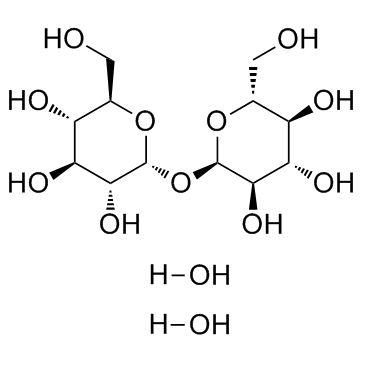| Synonyms: |
D(+)-Trehalose dihydrate;D-Trehalose, dihydrate ?,?-Trehalose, dihydrate;D(+)trehalose dihydrate cell*culture tested;D(+)trehalose dihydrate;D(+)trehalose reduced metal ion content dihydrate;D(+)Trehalose;alpha-D-Glucopyranosyl-alpha-D-glucopyranoside;D-(+)-Trehalose;D-(+)-Trehalose dihydrate;D(+)-Trehalose;D-(+)-Trehalose Dihy;D-Trehalose dihydrate;Trehalose;TREHALOSE DIHYDRATE, D-(+)-(RG) PrintBack;α,α-Trehalose;D(+)-Trehalose dihydrate (for injection);Trehalose dihydrate;a,a-Trehalose;alpha,alpha-Trehalose dihydrate;7YIN7J07X4;d-trehalose-dihyd;Mycose,1-O-alpha-D-glucopyranosyl-alpha-D-glucopyranoside;AK117470;dextro-trehalose dihydrate;(2R,3S,4S,5R,6R)-2-(hydroxymethyl)-6-[(2R,3R,4S,5S,6R)-3,4,5-trihydroxy-6-(hydroxymethyl)tetrahydropyran-2-yl]oxy-tetrahydropyran-3,4,5-triol;a,a-D-Trehalose dihydrate;D;α,α-Trehalose dihydrate;D-(+)-Trehalose dihydrate (D-Trehalose dihydrate; alpha,alpha-Trehalose dihydrate);a,a-Trehalose dihydrate;99-20-7 (anhydrous);Trehalose, United States Pharmacopeia (USP) Reference Standard;D-(+)-Trehalose dihydrate, from Saccharomyces cerevisiae, >=99%;AKOS016010526;TREHALOSE DIHYDRATE [EP MONOGRAPH];(2R,3S,4S,5R,6R)-2-(hydroxymethyl)-6-[(2R,3R,4S,5S,6R)-3,4,5-trihydroxy-6-(hydroxymethyl)oxan-2-yl]oxyoxane-3,4,5-triol;dihydrate;Trehalose (for injection) (sterile);2,2'-(1,6-Hexanediyldioxy)bisbenzaldehyde;S3992;(2R,2'R,3S,3'S,4S,4'S,5R,5'R,6R,6'R)-6,6'-Oxybis(2-(hydroxymethyl)tetrahydro-2H-pyran-3,4,5-triol) dihydrate;.ALPHA., .ALPHA.-TREHALOSE DIHYDRATE;Q27269028;D-(+)-Trehalose dihydrate, for microbiology, >=99.0%;D70602;D-Trehalose; ,-Trehalose;DPVHGFAJLZWDOC-PVXXTIHASA-N;DTXCID9027948;D-(+)-Trehalose dihydrate, from Saccharomyces cerevisiae, powder, BioReagent, suitable for cell culture, suitable for insect cell culture, >=99%;D-(+)-Trehalose dihydrate, from Saccharomyces cerevisiae, BioReagent, plant cell culture tested;BP-20564;MFCD00071594;FEMA NO. 4600;TREHALOSE DIHYDRATE [MI];AS-11785;TREHALOSE, DIHYDRATE;DTXSID3047972;MYCOSE DIHYDRATE;Trehalose dihydrate; ?-d-Glucopyranosyl ?-d-glucopyranoside dihydrate (?,?-trehalose dihydrate);a-d-glucopyranosyl-a-d-glucopyranoside;D-Trehalose dihydrate 1000 microg/mL in Water;Trehalose dihydrate, cell culture;Trehalose dihydrate, European Pharmacopoeia (EP) Reference Standard;D-Trehalose dihydrate; ,-Trehalose dihydrate;Trehalose, Pharmaceutical Secondary Standard; Certified Reference Material;CCG-268385;SCHEMBL166078;Tox21_201106;D-(+)-Trehalose dihydrate, Vetec(TM) reagent grade, >=99%;.ALPHA.-D-GLUCOPYRANOSYL-.ALPHA.-D-GLUCOPYRANOSIDE DIHYDRATE;D-(+)-Trehalose dihydrate, from Saccharomyces cerevisiae, >=98.5% (HPLC);a-D-Glucopyranosyl-a-D-glucopyranoside dihydrate;CHEMBL3188936;HMS3885G16;2-(hydroxymethyl)-6-[3,4,5-trihydroxy-6-(hydroxymethyl)tetrahydropyran-2-yl]oxy-tetrahydropyran-3,4,5-triol dihydrate;D-(+)-Trehalose dihydrate;alpha-D-Glucopyranoside,... |






















